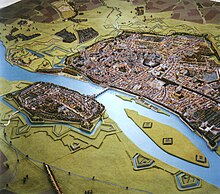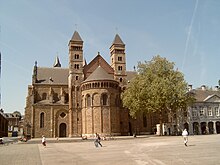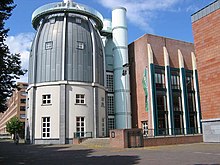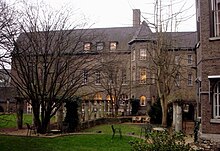Maastricht
Maastricht
Mestreech | |
|---|---|
Municipality | |
 View of the Maastricht city centre and Vrijthof Square from the tower of Sint-Jans Church (Sint-Janskerk) | |
|
| |
| Anthem: Mestreechs Volksleed | |
 | |
| Country | |
| Province | |
| COROP | South Limburg |
| Settled | ≈ 500 BC |
| City rights | 1204 |
| City subdivisions | 40 neighbourhoods |
| Government | |
| • Body | Gemeenteraad Maastricht |
| • Mayor | Onno Hoes (VVD) |
| Area (2006) | |
| • Total | 60.06 km2 (23.19 sq mi) |
| • Land | 56.80 km2 (21.93 sq mi) |
| • Water | 3.26 km2 (1.26 sq mi) |
| Population (31 October 2012) | |
| • Total | 122,121 |
| • Density | 2,017/km2 (5,220/sq mi) |
| • Demonym | (Dutch) Maastrichtenaar; (Limb.) Mestreechteneer or Sjeng |
| Source: CBS, Statline. | |
| Time zone | UTC+1 (CET) |
| • Summer (DST) | UTC+2 (CEST) |
| Postal code(s) | 6200 AA - 6229 ZZ |
| Area code | 043 |
| Website | http://www.maastricht.nl/ |
Maastricht ([maːˈstʁɪçt] (southern Dutch and locally) or [maːˈstɾɪxt] ⓘ (northern); Limburgish (incl. Maastrichtian) Mestreech [məˈstʁeːç]; French Maëstricht (archaic); Spanish Mastrique (archaic)) is a city in the Netherlands. It is located on both sides of the Meuse river (Dutch: Maas) in the southern part of the Dutch province of Limburg, of which it is the capital.
Maastricht developed from a Roman settlement to a religious centre, a garrison city and an early industrial city.[1] Nowadays, it is known as a city of history, culture, local folklore and education,[2] and has the second highest amount (numbering 1677) of national heritage sites (Rijksmonumenten) in the Netherlands (after Amsterdam). Furthermore, it has become known, by way of the Maastricht Treaty, as the birthplace of the European Union, European citizenship, and the single European currency, the euro.[3][4] The town is popular with tourists for shopping and recreation, and has a large growing international student population. Maastricht is a member of the Most Ancient European Towns Network[5] and is part of the Meuse-Rhine Euroregion, which includes nearby cities Aachen, Eupen, Hasselt, Liège and Tongeren.
History
Etymology and 'oldest city in the Netherlands' dispute
The name Maastricht is derived from Latin Trajectum ad Mosam (or Mosae Trajectum), meaning 'crossing at the Meuse', and referring to the bridge built by the Romans. The Latin name first appears in medieval documents and it is not known whether this was Maastricht's official name during Roman times.
There is some debate as to whether Maastricht is the oldest city in the Netherlands. Some people consider Nijmegen the oldest, mainly because it was the first settlement in the Netherlands to receive Roman city rights. Maastricht never did, but it may be considerably older as a settlement. In addition, Maastricht can claim uninterrupted habitation since Roman times. A large number of archeological finds confirms this. Nijmegen has a gap in its history: there is practically no evidence of habitation in the early Middle Ages.
A resident of Maastricht is referred to as Maastrichtenaar whilst in the local dialect it is either Mestreechteneer or, colloquially, Sjeng (derived from the formerly popular French name Jean).




Early history
Neanderthal remains have been found to the west of Maastricht (Belvédère excavations). Of a later date are Paleolithic remains, between 8,000 and 25,000 years old. Celts lived here around 500 BC, at a spot where the river Meuse was shallow and therefore easy to cross.
It is not known exactly when the Romans arrived in Maastricht, or whether the settlement was founded by them. It is known, though, that the Romans built a bridge over the Meuse in the 1st century AD, during the reign of Augustus Caesar. The bridge was an important link in the main road between Bavay and Cologne. Roman Maastricht was probably relatively small. Remains of the Roman road, the bridge, a religious shrine, a Roman bath, a granary, some houses and the 4th-century castrum walls and gates, have been excavated. Fragments of provincial Roman sculptures, as well as coins, jewelry, glass, pottery and other objects from Roman Maastricht are on display in the exhibition space of the city's public library (Centre Céramique).
According to legend, the Armenian-born Saint Servatius, bishop of Tongeren, died in Maastricht in 384 and was buried there along the Roman road, outside the castrum. According to Gregory of Tours it was bishop Monulph who, around 570, built the first stone church on the grave of Servatius, the present-day Basilica of Saint Servatius. The city remained an early Christian diocese until it lost this position to nearby Liège in the early 8th century.
Middle Ages
In the early Middle Ages Maastricht was, along with Aachen and the area around Liège, part of the heartland of the Carolingian Empire. The town was an important centre for trade and manufacturing. Merovingian coins minted in Maastricht have been found in many places throughout Europe. In the 10th century Maastricht briefly became the capital of the duchy of Lower Lorraine.
During the 12th century the town flourished culturally. The provosts of the church of Saint Servatius held important positions in the Holy Roman Empire during this era. The city's two main churches were largely rebuilt and redecorated. Maastricht Romanesque stone sculpture is regarded as one of the highlights of Mosan art. Maastricht painters were praised by Wolfram von Eschenbach in his Parzival. Around the same time, the poet Henric van Veldeke wrote a legend of Saint Servatius, one of the earliest works in Dutch literature.
Shortly after 1200 the city received dual authority, with the prince-bishops of Liège and the dukes of Brabant holding joint sovereignty over the city. Maastricht received city rights in 1204. Soon afterwards the first ring of medieval walls were built. Throughout the Middle Ages, the city remained a centre for trade and manufacturing of wool and leather but gradually economic decline set in. After a brief period of economic prosperity in the 15th century, the city's economy suffered during the wars of religion of the 16th and 17th centuries, and recovery did not happen until the industrial revolution in the early 19th century.
16th to 19th century
The important strategic location of Maastricht resulted in the construction of an impressive array of fortifications around the city during this period. The Spanish and Dutch garrisons became an important factor in the city's economy. In 1579 the city was sacked by the Spanish army under general Alexander Farnese, Duke of Parma (Siege of Maastricht, 1579). For over fifty years the Spanish crown took over the role of the dukes of Brabant in the joint sovereignty over Maastricht. In 1632 the city was conquered by Frederick Henry, Prince of Orange and the Dutch States General replaced the Spanish crown in the joint government of Maastricht.
Another Siege of Maastricht (1673) took place during the Franco-Dutch War. In June 1673, Louis XIV laid siege to the city because French battle supply lines were being threatened. During this siege, Vauban, the famous French military engineer, developed a new strategy in order to break down the strong fortifications surrounding Maastricht. His systematic approach remained the standard method of attacking fortresses until the 20th century. On 25 June 1673, while preparing to storm the city, captain-lieutenant Charles de Batz de Castelmore, also known as the comte d'Artagnan, was killed by a musket shot outside Tongerse Poort. This event was immortalized in Alexandre Dumas' novel The Vicomte de Bragelonne, part of the D'Artagnan Romances (D'Artagnan is one of the Mousquetaires du Roi, or Three Musketeers, in this series). French troops occupied Maastricht from 1673 to 1678.
In 1748 the French once again conquered the city at what is known as the Second French Siege of Maastricht, during the War of Austrian Succession. The French took the city one last time in 1794, when the condominium was dissolved and Maastricht was annexed to the First French Empire. For twenty years Maastricht was the capital of the French département of Meuse-Inférieure.
After the Napoleonic era, Maastricht became part of the United Kingdom of the Netherlands in 1815. It was made the capital of the newly formed Province of Limburg (1815–1839). When the southern provinces of the newly formed kingdom seceded in 1830 (Belgian Revolution), the Dutch garrison in Maastricht remained loyal to the Dutch king, William I of the Netherlands, even when most of the inhabitants of the town and the surrounding area sided with the Belgian revolutionaries. In 1831, arbitration by the Great Powers allocated the city to the Netherlands. However, neither the Dutch nor the Belgians agreed to this and it was not until the 1839 Treaty of London that the arrangement was implemented.
Because of its eccentric location in the Netherlands, and its geographical and cultural proximity to Belgium, integration of Maastricht and Limburg into the Netherlands did not come about easily. Maastricht retained a distinctly non-Dutch appearance during much of the 19th century and it was not until the First World War that the city was forced to look northwards.
20th century and onwards
Maastricht did not escape the ravages of World War II. It was quickly taken by the Germans during the Battle of Maastricht in May 1940, but on 14 September 1944 it was also the first Dutch city to be liberated by allied forces. The three Meuse bridges were destroyed or severely damaged during the war. The majority of Maastricht Jews were murdered in Nazi concentration camps.
The latter half of the century saw the decline of traditional industries (such as the famous Maastricht potteries) and a shift to a service economy. Maastricht University was founded in 1976. Several European institutions have found their base in Maastricht. In 1992, the Maastricht Treaty was negotiated and signed here, leading to the creation of the European Union and the euro.[6]
In recent years, under mayor Gerd Leers, Maastricht launched a campaign against drug-related problems. Leers instigated a controversial plan to relocate some of the cannabis coffee shops—where the purchase of soft drugs in limited quantities is tolerated—from the city centre to the outskirts, in an attempt to stop (foreign) buyers from causing trouble in the downtown area.[7] Although the so-called "coffee corner plan" has not been entirely abandoned, the new mayor Onno Hoes has given priority to the Dutch government's approach of limiting entrance to 'coffee shops' to Dutch adults only, and to tackle the problem of drug runners in cooperation with the city of Rotterdam (where the majority of drug runners are from).
On a positive note, large parts of the city centre were thoroughly refurbished in recent years, including the area around the main railway station, the main shopping streets, the Entre Deux and Mosae Forum shopping centres, and the Maasboulevard promenade along the Meuse. Also, a new quarter, including the new Bonnefanten Museum, a public library, a theater and several housing blocks designed by international architects, was built on the grounds of the former Céramique potteries near the town centre. As a result, Maastricht looks notably smarter. Further large-scale projects, such as the redevelopment of the Sphinx and Belvédère areas, are underway.
Climate
Maastricht features the same climate as most of the Netherlands (Cfb, Oceanic climate), however, due to its more inland location in between hills, summers tend to be warmer (especially in the Meuse valley, which lies 70 meters lower than the meteorological station) and winters a bit colder, although the difference is only remarkable at a few days a year. Notable is the 2nd highest temperature recorded in the Netherlands, and the highest temperature of a still existing station on June 27, 1947 at 38.4 °C (101.1 °F).[8]
| Climate data for Maastricht | |||||||||||||
|---|---|---|---|---|---|---|---|---|---|---|---|---|---|
| Month | Jan | Feb | Mar | Apr | May | Jun | Jul | Aug | Sep | Oct | Nov | Dec | Year |
| Mean daily maximum °C (°F) | 5.2 (41.4) |
6.1 (43.0) |
10.1 (50.2) |
14.0 (57.2) |
18.3 (64.9) |
20.9 (69.6) |
23.3 (73.9) |
23.0 (73.4) |
19.1 (66.4) |
14.7 (58.5) |
9.2 (48.6) |
5.8 (42.4) |
14.1 (57.5) |
| Daily mean °C (°F) | 2.7 (36.9) |
3.1 (37.6) |
6.3 (43.3) |
9.3 (48.7) |
13.5 (56.3) |
16.2 (61.2) |
18.4 (65.1) |
18.0 (64.4) |
14.7 (58.5) |
10.9 (51.6) |
6.4 (43.5) |
3.5 (38.3) |
10.3 (50.4) |
| Mean daily minimum °C (°F) | 0.0 (32.0) |
0.0 (32.0) |
2.6 (36.7) |
4.7 (40.5) |
8.5 (47.3) |
11.3 (52.3) |
13.5 (56.3) |
13.2 (55.8) |
10.5 (50.9) |
7.2 (45.0) |
3.5 (38.3) |
0.9 (33.6) |
6.3 (43.4) |
| Average precipitation mm (inches) | 65.3 (2.57) |
57.4 (2.26) |
61.8 (2.43) |
45.1 (1.78) |
65.9 (2.59) |
70.5 (2.78) |
69.6 (2.74) |
72.3 (2.85) |
61.6 (2.43) |
67.2 (2.65) |
65.3 (2.57) |
70.8 (2.79) |
772.8 (30.44) |
| Average precipitation days (≥ 0.1 mm) | 17 | 15 | 16 | 13 | 15 | 14 | 14 | 14 | 14 | 15 | 17 | 18 | 182 |
| Average relative humidity (%) | 87 | 84 | 80 | 74 | 73 | 75 | 75 | 76 | 82 | 85 | 89 | 89 | 81 |
| Mean monthly sunshine hours | 59.9 | 79.3 | 119.3 | 164.0 | 194.9 | 188.9 | 202.8 | 187.3 | 140.0 | 113.6 | 65.9 | 44.9 | 1,560.8 |
| Source: KNMI [9] | |||||||||||||
Culture and tourism
Sights of Maastricht





Maastricht is known for its picturesque squares, romantic streets, and historical buildings. The tourist information office (VVV) is located in the Dinghuis, a 15th-century former town hall and law courts building on the corner of Grote Staat and Kleine Staat. The main sights include:
- City Fortifications, including:
- Helpoort: a 13th-century town gate, the oldest in the Netherlands
- Fragments of the first and second medieval city walls
- Hoge Fronten (or Linie van Du Moulin): remnants of 17th- and 18th-century fortifications with a number of well-preserved bastions and an early 19th-century fortress, Fort Willem
- Casemate, an underground network of tunnels, built as sheltered emplacements for guns and cannons. These tunnels run for several miles underneath the city's fortifications. Guided tours are available.
- Binnenstad: inner-city shopping district, including Grote and Kleine Staat, and high-end shopping street Stokstraat. Maastricht is also well known for its cafés, pubs and restaurants.
- Dinghuis, a medieval courthouse with an early Renaissance façade
- Entre Deux, a recently rebuilt shopping centre which has won several international awards.[10] It includes a bookstore located inside a former 13th-century Dominican church. In 2008, British newspaper The Guardian proclaimed this the world's most beautiful bookshop.[11]
- Vrijthof, the best-known square in the city. Sights:
- Sint-Servaas Basiliek, the Romanesque church of Saint Servatius. The tomb of Saint Servatius in the crypt is a favoured place of pilgrimage: Pope John Paul II visited here in 1985.
- Sint-Janskerk, a sandstone Gothic church dedicated to Saint John the Baptist with a distinctive red tower.
- Theater aan het Vrijthof, the main city theatre, with a Neoclassical façade.
- Onze Lieve Vrouweplein, a picturesque tree-lined square with an abundance of pavement cafes. Sights:
- Basilica of Our Lady, an 11th-century church.
- Derlon Museumkelder, a small museum in the basement of Hotel Derlon with Roman remains.
- Markt; the Market Square was completely refurbished in 2006-2007 and is now virtually traffic free. Sights include:
- The Town Hall, built in the 17th century by Pieter Post.
- Mosae Forum, a brand new shopping center and civic building designed by Jo Coenen and Bruno Albert. Citroën Miniature Cars, the world's largest exposition of Citroën miniature cars, is inside the Mosae Forum parking garage below the square.
- Bassin, a restored early 19th-century inner harbor with restaurants and cafés. The surroundings are currently being developed into a cultural hotspot.
- Jekerkwartier, a picturesque neighbourhood with the small river Jeker popping up between old houses and remnants of city walls.
- Wyck: the old quarter on the right bank of the Meuse river. Rechtstraat is the main shopping street in Wyck with a mix of specialty shops, art galleries and restaurants.
- Céramique, a modern neighbourhood on the site of the former Céramique potteries. Now a showcase of architectural highlights:
- Bonnefanten Museum by Aldo Rossi.
- Centre Céramique (a public library and exhibition space) by Jo Coenen.
- La Fortezza by Mario Botta.
- Siza Tower by Álvaro Siza Vieira.
- Also buildings by MBM, Cruz y Ortiz, Luigi Snozzi, Aurelio Galfetti, Herman Hertzberger, Charles Vandenhove, Bob Van Reeth and Wiel Arets.
- Parks: there are various parks in Maastricht. Of particular note are the following:
- Stadspark, the main public park on the west bank of the river.
- Monsigneur Nolenspark, an extension of Stadspark with remnants of the medieval city walls.
- Aldenhofpark, another extension of Stadspark, with a statue of d'Artagnan.
- Charles Eykpark, a modern park between the public library and Bonnefanten Museum on the east bank of the Meuse river
- Griendpark, a modern park on the east bank of the river with an inline-skating and skateboarding course.
- Sint-Pietersberg: modest hill just south of the city, peaking at 171 metres (561 ft) above sea level. Sights:
- Fort Sint-Pieter, an 18th-century fortress fully restored in 2008.
- Grotten Sint-Pietersberg (caves) - a sandstone (marl) quarry with a network of man-made tunnels. Guided tours are available.
- Kasteelruïne Lichtenberg, a farmstead containing a ruined medieval castle keep.
- D'n Observant, an artificial hilltop on Sint-Pietersberg.
- Sint Servaasbrug, the oldest bridge in the Netherlands
Museums in Maastricht


- Bonnefanten Museum is the foremost museum for old masters and contemporary fine art in the province of Limburg. The collection features medieval sculpture, early Italian painting, Southern Netherlandish painting, and contemporary art.
- Museum aan het Vrijthof is a local history museum in the 16th-century Spanish Government building, featuring period rooms with 17th- and 18th-century furnishings, Maastricht silver, porcelain, glassware, Maastricht pistols, and a collection of 17th- and 18th-century Dutch paintings and 20th-century paintings from local artists.
- The Treasury of the Basilica of Saint Servatius includes religious artifacts from the 4th–20th centuries, notably those related to Saint Servatius. Highlights include the shrine, the key and the crosier of Saint Servatius, and the reliquary bust donated by Alexander Farnese, Duke of Parma.
- The Treasury of the Basilica of Our Lady includes religious artifacts.
- Derlon Museumkelder is a preserved archeological site in the basement of a hotel with Roman and pre-Roman remains.
- Natural History Museum exhibits collections relating to the geology, paleontology and flora and fauna of Limburg. A highlight in the collection is the skeleton of a Mosasaur.
Events and festivals
- The European Fine Art Fair (TEFAF), the world's leading art and antiques fair (March).
- Preuvenemint, a large culinary event held on the Vrijthof square (August).
- Magic Maastricht, a winter-themed funfair and Christmas market held on Vrijthof square and other locations throughout the city (December/January).
- European Model United Nations (EuroMUN), an annual international conference in May and the second largest of its kind in Europe.
- Amstel Gold Race, an international cycling race which starts in Maastricht (usually April).
- Jumping Indoor Maastricht, an international concours hippique (showjumping).
- Maastrichts Mooiste, an annual running and walking event.
- Musica Sacra, a festival of religious (classical) music (September).
- Jazz Maastricht, a jazz festival formerly known as "Jeker Jazz" (autumn).
- Nederlandse Dansdagen, a modern dance festival (October).
- KunstTour, an annual art festival (May).
- Inkom, the traditional opening of the academic year and introduction for new students of Maastricht University (August).
- Carnival (Dutch: Carnaval, Limburgish and Maastrichtian: Vastelaovend) - a traditional 3-day festival in the southern part of the Netherlands (February/March). In Maastricht it is largely celebrated outdoors.
- 11de van de 11de, the official start of the carnival season (November 11).
Furthermore, the Maastricht Exposition and Congress Centre (MECC) hosts many events throughout the year.
Cannabis
On 16 December 2010, the Court of Justice of the European Union upheld a local Maastrict ban on the sale of cannabis to foreign tourists, restricting coffee shops to residents of Maastricht.[12] The ban did not affect scientific or medical usage. While the ban is now legal to enforce, its future is uncertain as the city council of Maastricht and other cities have voted against the planned "cannabis pass system".[13]
Demographics and language
Total population
Inhabitants by country of birth
|
















































